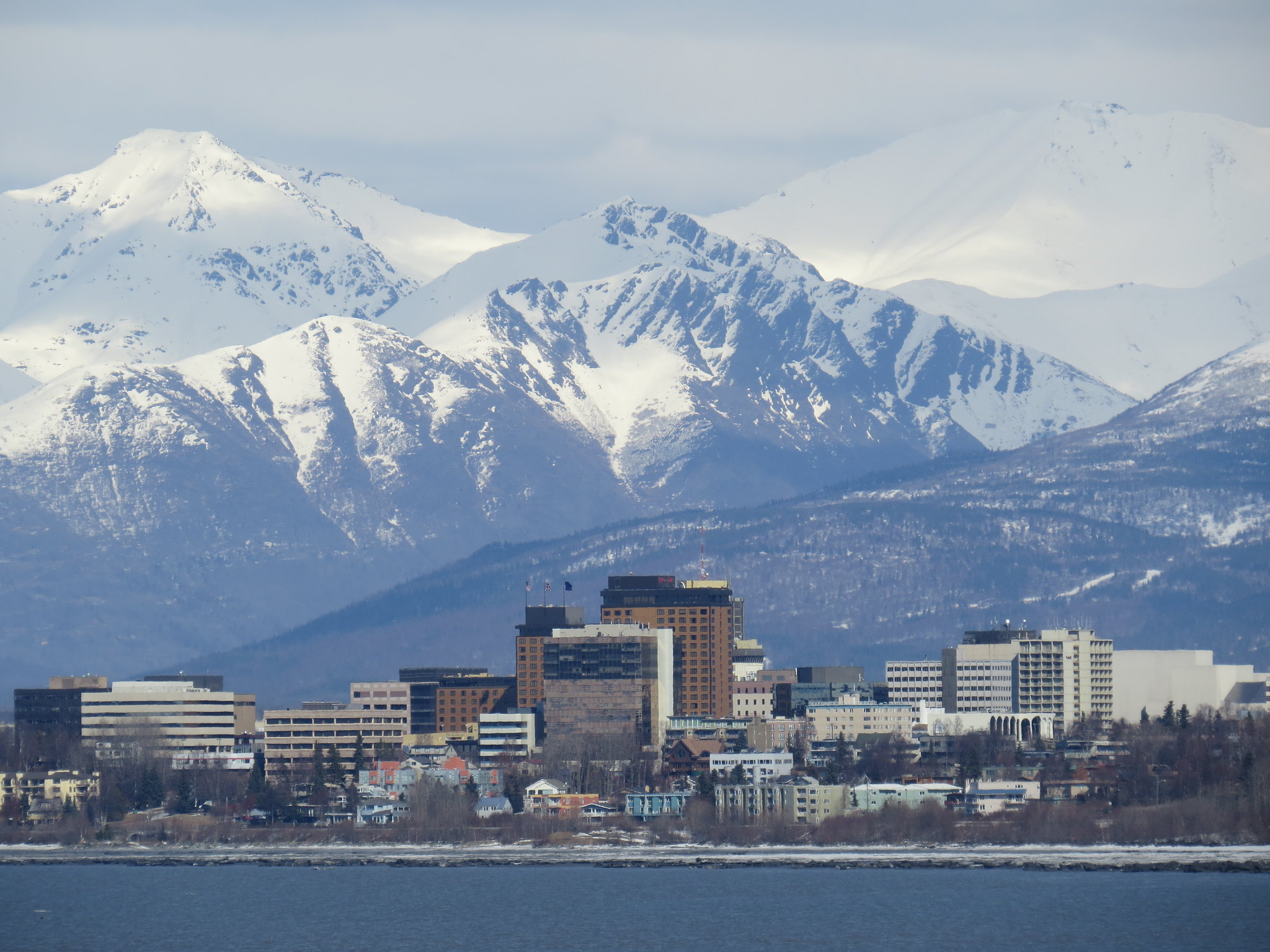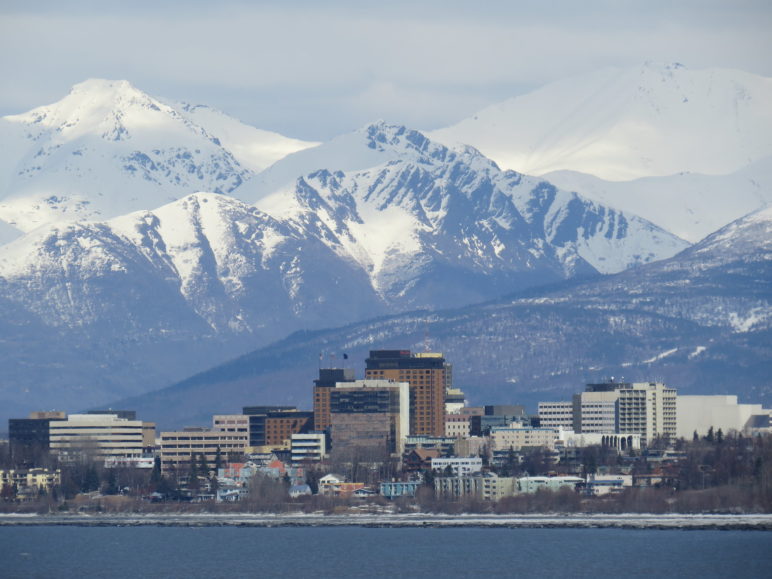Anchorage’s new mayor, Dave Bronson, is on point in putting downtown near the top of his to-do list. A world-class urban center in Alaska’s largest city has long been the Holy Grail for Anchorage leaders. The quest has brought some success: walkable blocks of office buildings, hotels, restaurants, and shops; the Anchorage Museum and the Performing Arts Center; and, not far from City Hall, two trailheads to the “Moose Loop,” a 32-mile paved trail network.
What no one has managed to figure out, though, is how to keep the downtown economy humming like it’s always the peak of summer, when office workers, other Alaskans, and tourists are dining out, buying things, and paying for lodging in the downtown core. Achieving this feat would be a huge and historic accomplishment for the Bronson administration.
The mayor’s transition plan focuses on downtown as a key driver of economic revitalization for the city. His team wants a vibrant year-round business environment and intends to focus on supporting tourism, filling office space, and boosting retail sales. This is a great start, but it is not enough to fulfill the goal of a four-season downtown. Tourists do not come in large numbers outside the May-to-September window. Office workers are only downtown on weekdays, not weekends, and the pandemic has made in-person work either optional or part-time for many. Downtown restaurants, shops, and service businesses need a steady demand base to flourish.
The only way to create that permanent pool of customers is to get more people living downtown.
Generating interest in downtown living will not be the issue. A 2018 survey by the Anchorage Economic Development Corp’s housing group found downtown was among the top three neighborhoods preferred by Anchorage residents. When asked to choose their top three neighborhoods from a menu of 17 choices, one third of 1,114 respondents included downtown in their lists. Of the 175 senior residents responding the survey, 30 percent said they would want to live downtown. Seniors were the group most likely to want to live in close proximity to shopping, with 46 percent saying that was a top priority.
And yet, Anchorage has missed out on the nationwide shift toward urban living. The list of recently constructed residential projects of any size is thin: Cook Inlet Housing Authority built the 50-unit Elizabeth Place, a mix of affordable and market-rate apartments with ground-level retail space. It also transformed the former Duke’s 8th Avenue Hotel into 28 one- and two-bedrooms that rent for $750 to $1,200. Over on 8th and K St, Developer Shaun Debenham plans to break ground next year on 44 apartments at Block 96 Flats. The $6.2 million complex is on track to be the first to offer all units at market rates downtown in four decades, but still needed some public financing from the Anchorage Community Development Authority to pencil out.
Helping developers build more housing to meet a range of consumer preferences and price points is a ripe opportunity for the Bronson administration to leave a lasting legacy downtown and boost the business environment citywide. The quality and quantity of housing are foundational to a solid local economy, affecting the ability of companies, government, and organizations to retain and recruit employees. A 2021 business confidence report by the Anchorage Economic Development Corp found 32 percent of 210 employers surveyed said the availability and affordability of quality housing is either a significant or moderate barrier to growth.
The high costs of construction in Alaska present a major hurdle for builders downtown. Currently, the only projects that make financial sense target the upper tier of the housing market because those buyers can pay enough to give developers adequate return on their investment. But Anchorage can’t depend on a small number of wealthy residents to revitalize the downtown economy. For retailers, restaurateurs and other businesses to truly thrive downtown, we need young people, seniors, and families across the income spectrum who consider the blocks north of 9th avenue home.
The city has put in place some policies to encourage housing downtown, including tax abatement and letting developers choose how much parking to build, but it can do more. A few suggestions include partnering with developers to invest in projects; incentivizing housing builds on downtown’s numerous surface parking lots and other underdeveloped properties; mitigating offsite construction costs; zoning reform; and attracting foundational neighborhood businesses, like a grocery store. The Bronson administration has a great opportunity to improve the blocks surrounding City Hall. Here’s hoping they’ll take it.
Why Doesn’t Great Housing Downtown Already Exist?
Downtown has the bones to become a true neighborhood, one where a significant number of people actually live. It has the typical canopy of an urban ecosystem: office buildings, a performing arts center, the museum, and a wide variety of bars and eateries. The gridded blocks are short, making walking easier. And while many other American cities have to contend with a “moat” of unappealing real estate surrounding their downtowns, Anchorage has desirable residential neighborhoods immediately adjacent to its city center, including South Addition and Government Hill.
Despite the apparent demand for living in the heart of downtown, Anchorage planners and developers have for decades prioritized single-detached housing on freshly cleared land. Residential building has slowed significantly in the decades since the oil-driven economic boom (and subsequent bust) of the 1980s, but homes continue their spread into former wetlands and up the slopes of the Chugach mountains. The sprawl adds to the costs of providing city services, like police and fire protection, and road maintenance.
The desire is there on the part of buyers and builders, but the cost of producing housing downtown has so far proven to be higher than what most potential residents seem willing to spend. For homebuilders, putting up a single detached home in suburban Anchorage and selling it for half a million dollars is a much surer bet and far less logistically challenging than a downtown apartment project. And so, in 2021, when the housing market in Anchorage is going gangbusters, the biggest project happening downtown is not housing, but the $41 million refurbishment of the Key Bank office building.
The following factors contribute to the high project costs faced by homebuilders downtown:
- Land is expensive. Underdeveloped land riddles downtown with dead space. While not technically vacant, many parcels are surface parking lots. Surface lots are lucrative and relatively cheap to maintain, giving owners little incentive to sell at prices that would make an urban residential project pencil out.
- Construction is also expensive. In Anchorage, construction budgets are about 37 percent higher than the national average because of the cost of shipping building materials, labor costs, and the shortened construction season, according to a 2012 study by the McDowell Group. Materials for the larger housing types that are appropriate for a downtown (e.g. concrete, steel, elevators) are more expensive than materials for a standard wood frame detached house.
- Seismic concerns are very, very real. The Great Alaska earthquake of 1964 was the second-largest ever recorded in the world and devastated downtown. As a result, Anchorage has stringent seismic building codes that are expensive to meet for multi-story developments.
- Developers are on the hook for building or upgrading city infrastructure. Anchorage requires builders to shoulder improvements to surrounding roads and sidewalks, as well as sewage, water, and utility systems. Such expenses, known as “off-site costs,” can easily range into the tens of thousands of dollars per home.
What Has the City Done to Spur Homebuilding Downtown?
Non-profit developers can use government subsidies to fill the gap between the cost to build homes and prices people can afford. That’s why the nonprofit Cook Inlet Housing Authority is the most active developer of housing downtown. In recent years, the housing authority has drawn on federal grants to build Elizabeth Place and Qanchi Place. Cook Inlet Housing is an undisputed force in Anchorage housing development, but it cannot singlehandedly make downtown a vibrant urban neighborhood. Private developers bring a wealth of expertise, supply chain access, and the workforce necessary for a wider variety of housing that appeals to homebuyers across the economic spectrum.
The city has enacted a few key tax breaks and zoning allowances, but they have done little so far to entice a significant number of private developers.
No Parking Requirements
Excessive parking mandates routinely kill promising housing builds worldwide. Recognizing this, Anchorage did away with the policy of forcing builders to pave and paint a certain number of parking spots per residential unit. Instead in downtown the city allows for a “market-based” approach, that allows builders, not the city, decide how much parking to include based on their estimates of current and future demand.
Typically, adding denser housing options to an area leads to concerns about traffic congestion and parking shortages. But focusing on the downtown core as a site for housing that is more efficiently sized, less pricey, and close to amenities will remove at least some vehicles from the equation. At least a part of Anchorage can truly be a walking city, with the associated health benefits and fuel savings.
Property Tax Break
Developers who build a minimum of four new residential units in the heart of downtown, known as the “Central Business District,” can obtain a 12-year property tax break as long as they increase the total number of residential units on the property. The units can be priced at market rate and have no affordability requirements. The tax break applies to the value of all new units. Cook Inlet Housing Authority secured the tax break for its conversion of Duke’s 8th Avenue Hotel into Qanchi Place.
Deteriorated Properties Tax Exemption
The city can also defer or exempt taxes on properties under improvement anywhere in Anchorage that it had ordered to be vacated, condemned, or demolished. With few downtown projects using the exemption, it may be worth reviewing and possibly rewriting (see below). A $41 million office building renovation, which will not include residential space, is one of the few projects to use the exemption.
In the Works
The city is updating its Downtown Comprehensive Plan with an emphasis on supporting residential development and a streetscape to match. The plan in turn will inform future changes to the land use (Title 21) and building (Title 23) codes. One good change the Bronson administration is already proposing would remove residential setback requirements in downtown. A setback is the distance separating a structure from a street, other buildings, property lines, or natural features. must some of which have the potential to alleviate homebuilding costs downtown. Setbacks make little sense in downtowns because they reduce the amount of land available to build.
Another possible proposal involves rewriting rules on the size of the building allowed per square foot of land (also known as a “floor area ratio”). Developers can build bigger if they include certain amenities in and around their building. (This practice is called a “floor area ratio bonus.”) The city could change the list from amenities that were desirable in the past to those that are more in demand today. For example, instead of rewarding builders for installing bollards, reward them for wider sidewalks and solar panels.
More Ways to Help Create a Thriving Downtown
The private sector in Anchorage is not going to revitalize downtown on its own. Much as Alaska has helped the oil industry thrive through tax breaks and other favorable policies, the state’s largest city and economic center needs to work with builders to boost housing supply downtown. The following policy proposals for downtown Anchorage lay out ways the municipality can improve the quality of life for residents and visitors by working in concert with the private sector.
Unleash the power of ACDA
Block 96 Flats, a complex of 44 studio and one-bedroom apartments, is set to break ground next year. It’s the first larger market-rate project to rise in downtown in 40 years, with each unit renting for $1,100 to $1,500 a month. The $6.2 million project would not have been possible without $1.8 million in investment and land from the city’s Anchorage Community Development Authority (ACDA). ACDA can continue catalyzing downtown redevelopment using policy tools outlined in the 2040 Land Use Plan, including investment in projects, providing land developers can afford through acquisition of vacant or underused properties, and using its authority to sell, issue, retire, or service bonds to mitigate offsite construction costs (see below).
Lighten the costs of public infrastructure
The city can help offset the cost of improvements to public infrastructure supporting a housing development. One option would be to borrow against the tax revenue the project will generate, a practice known as “tax increment financing.” ACDA could take out a loan to say, build a water line, saving the developer from having to front the cash. The city would then designate the property taxes paid by future residents—revenue that would not have existed but for the housing development—to repay the loan principal and interest.
Advocate for cheaper public financing
The Alaska Industrial Development and Export Authority (AIDEA), a state corporation whose mission is to foster economic growth and diversification, provides low-interest loans that beat what developers can obtain from banks and other standard sources. AIDEA has provided loans to hotels, restaurants, and resource development projects across the state, but it requires a simple change in state statute to be able to finance multi-unit housing. The option to borrow from AIDEA would help housing developers immensely in simplifying the hunt for financing, both in Anchorage and statewide. The city of Anchorage and other members of the Alaska Municipal League could lobby the Legislature to allow for AIDEA to finance housing builds across Alaska.
Rewrite the Deteriorated Properties Tax Exemption
City officials could rewrite the requirements for obtaining a tax break on properties that have fallen into decay. The goal would be to make it easier for developers to apply and successfully obtain tax exemptions or deferrals. Currently, developers must submit detailed financial projections, which are typically confidential, proving to the city that the project would not be economically feasible without tax incentives. The requirements likely aim to prevent developers from receiving tax breaks on projects that would have happened without government assistance. But the practical consequence has been that developers very rarely use the incentive, calling it “burdensome,” according to the Anchorage Daily News.
A more effective policy might be to create a second, simpler way to qualify for the tax break. In certain zones of the city that have received insufficient redevelopment, and where certain types of redevelopment would create tangible community benefits, developers would not have to reveal their confidential project finance information. Instead, they would only have to show how a project would increase the assessed value of the property and benefit the community. Limiting this more simplified process to targeted redevelopment areas chosen by the city, such as downtown, could allay concerns about incentivizing projects that would have occurred without government assistance. (The existing application process for receiving a tax break would still apply outside the redevelopment areas.)
Attract a Grocery Store and Other Neighborhood Businesses
A generality often made about Alaskans is that we didn’t move here to live in a city and instead prefer homes on large lots with plenty of room to store our outdoor gear. But Anchorage is a highly transient city whose residents have lived in urban centers all over the world. Not everyone is into the suburban existence and its attendant responsibilities: spending hours on yardwork and snow removal; shouldering the high costs of maintaining a house; and having to get in the car for every errand. Many would appreciate a lower maintenance lifestyle where they could pick up groceries on foot, avoid driving to their favorite bar, and divert their time and money from house projects to hobbies and travel. (Of course, we’d still like a place to store our gear.)
Expanding the selection of urban amenities is a crucial step to meeting demand from this category of housing consumer. People will be more willing to pay for downtown housing when amenities are close to their doorstep. But there are no grocery stores or pharmacies downtown. Pet, book, and music stores; clothing and shoe repair; housewares; and medical services are also in short supply. In concert with stimulating more housing development, the Bronson administration could explore ways to attract those and other foundational neighborhood businesses north of the Park Strip. Office workers and tourists would no doubt patronize them. But it’s residents who would keep them open.









